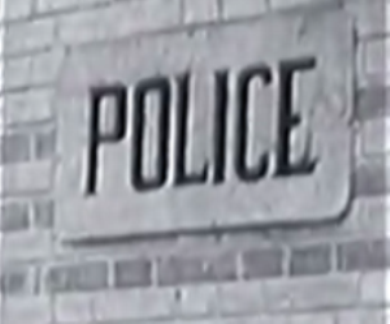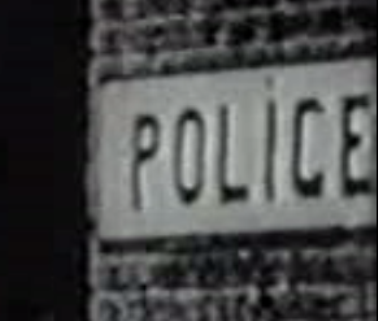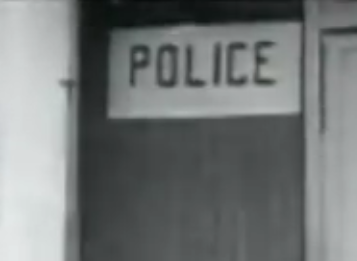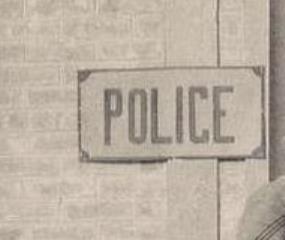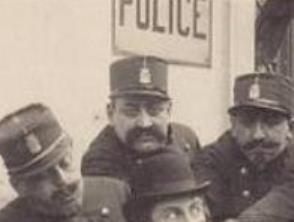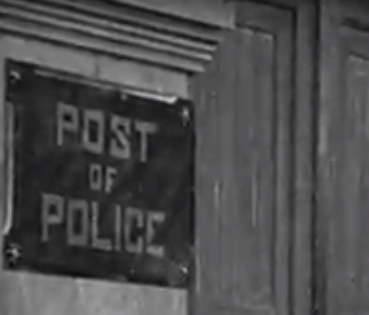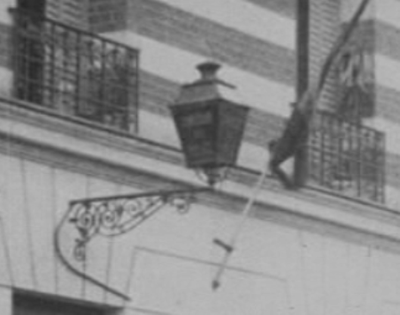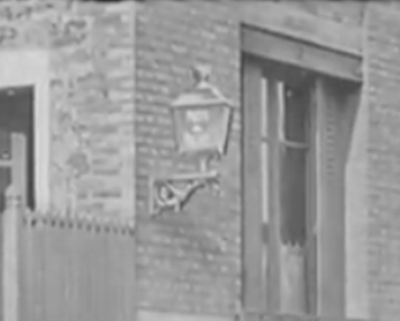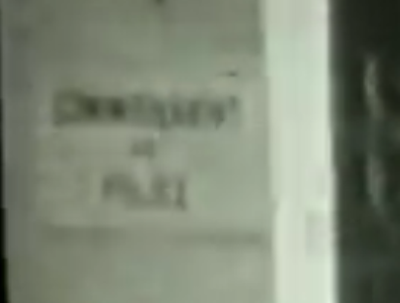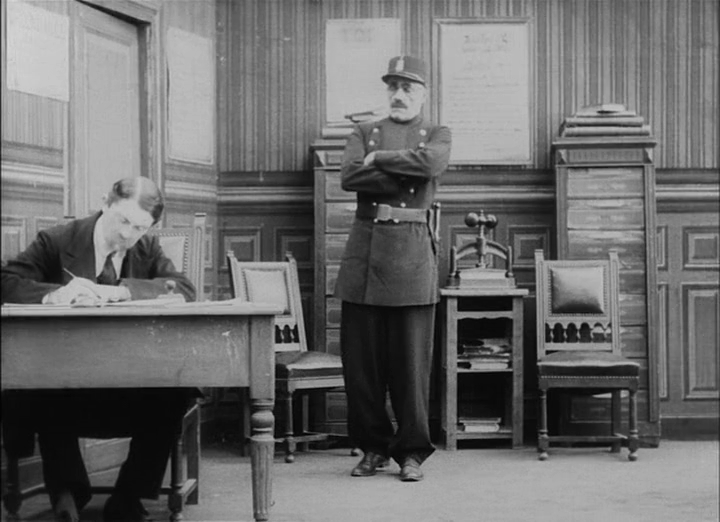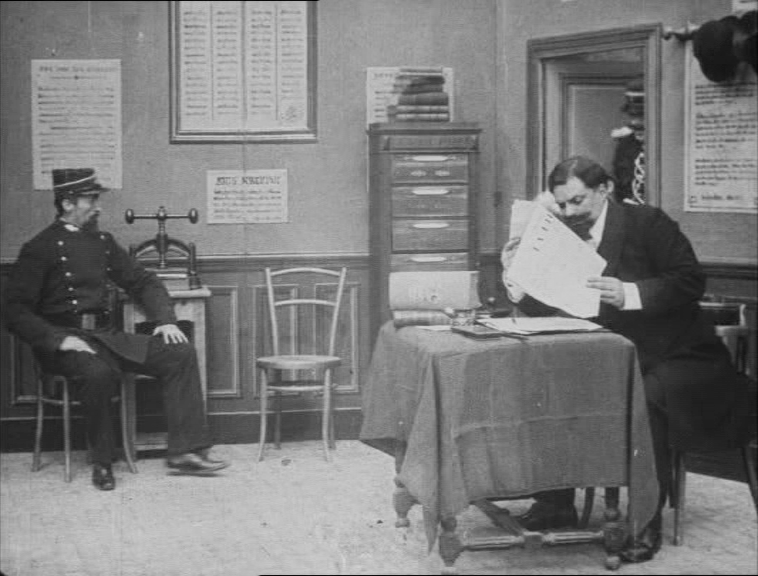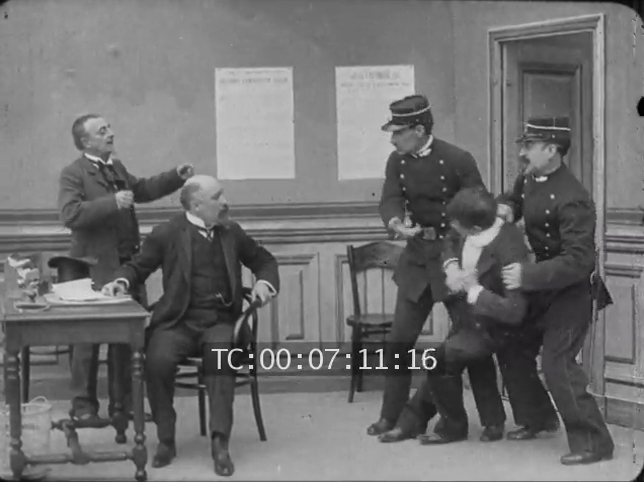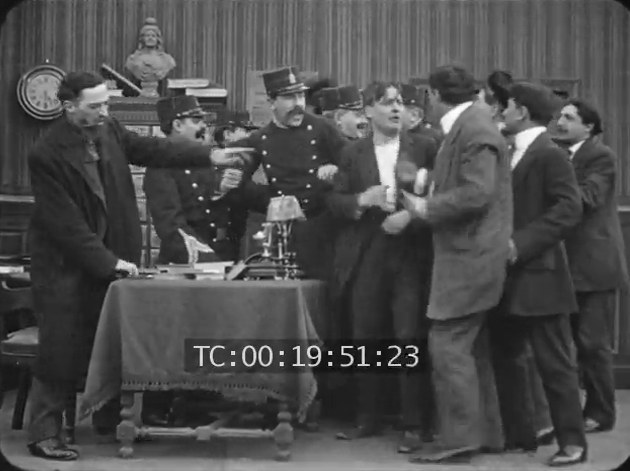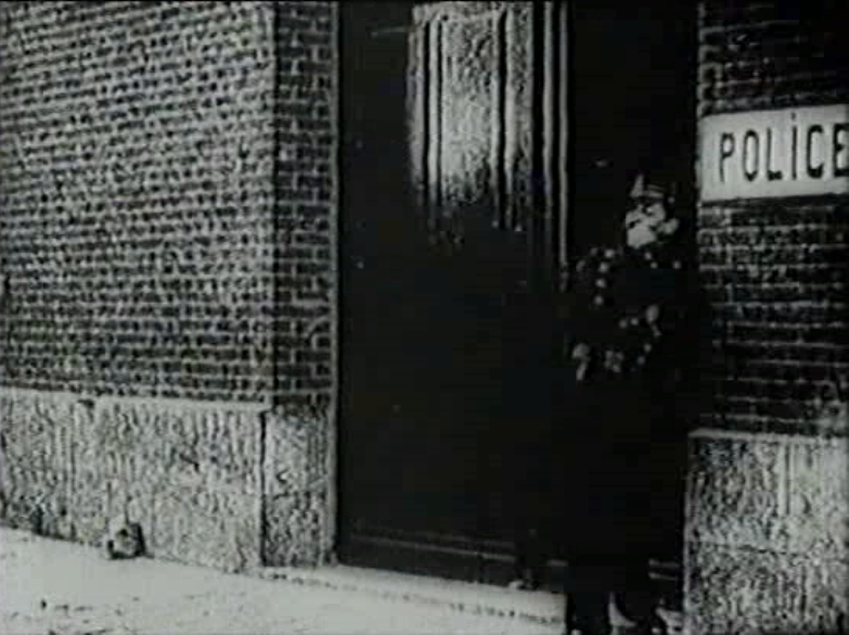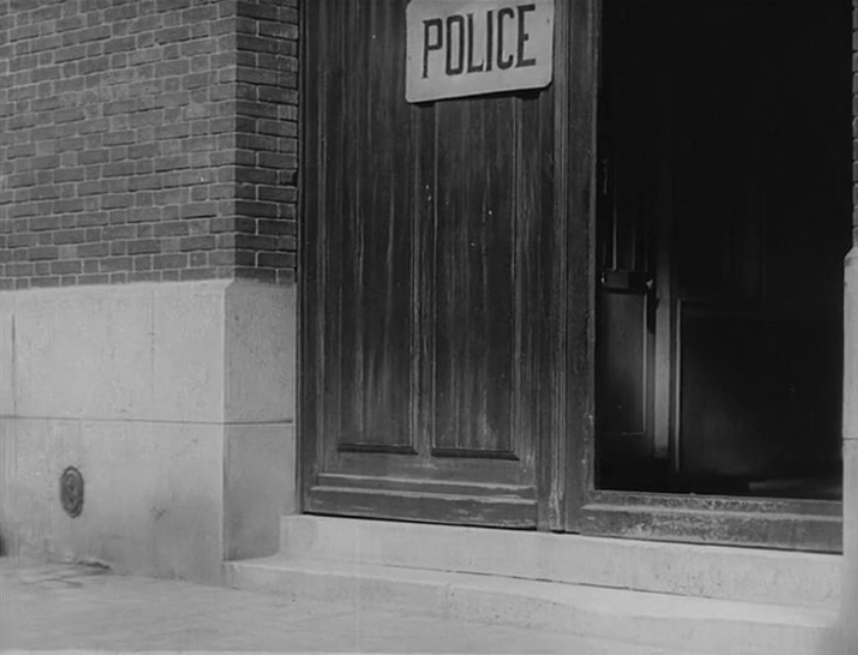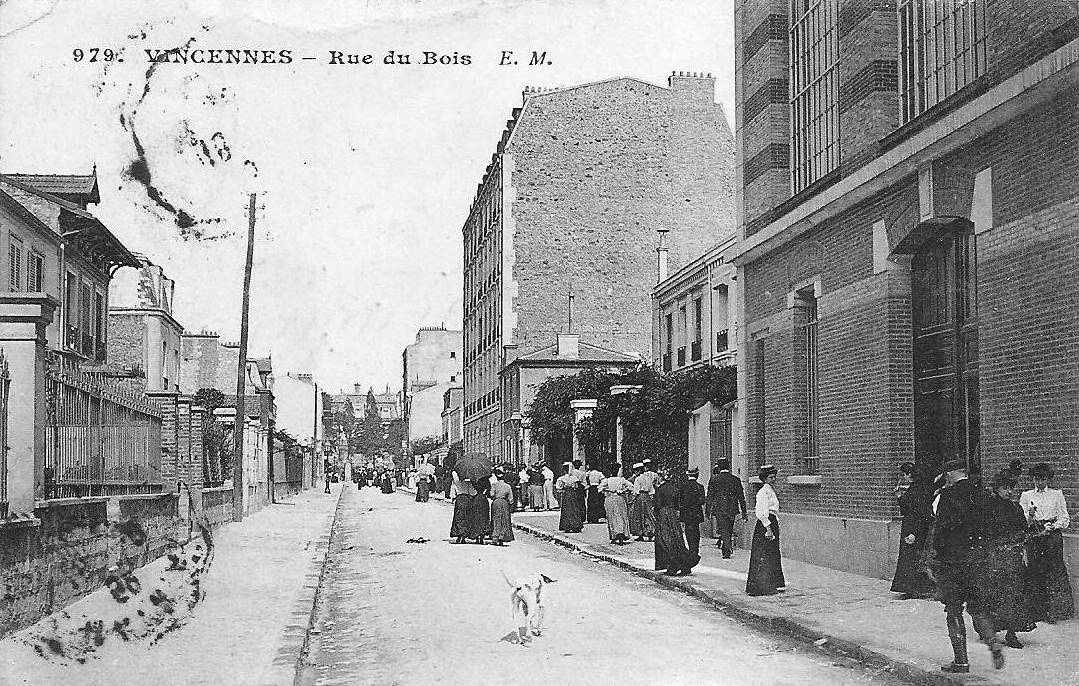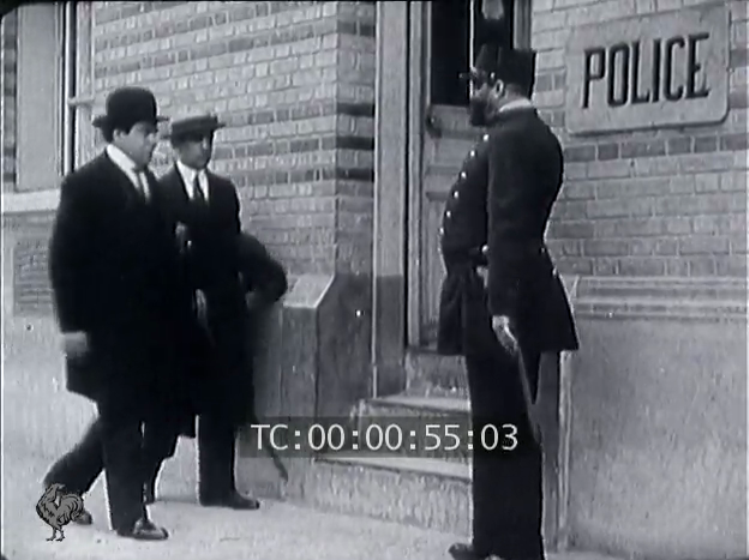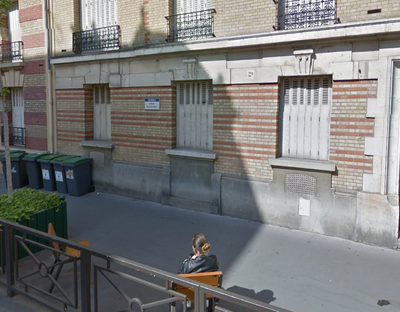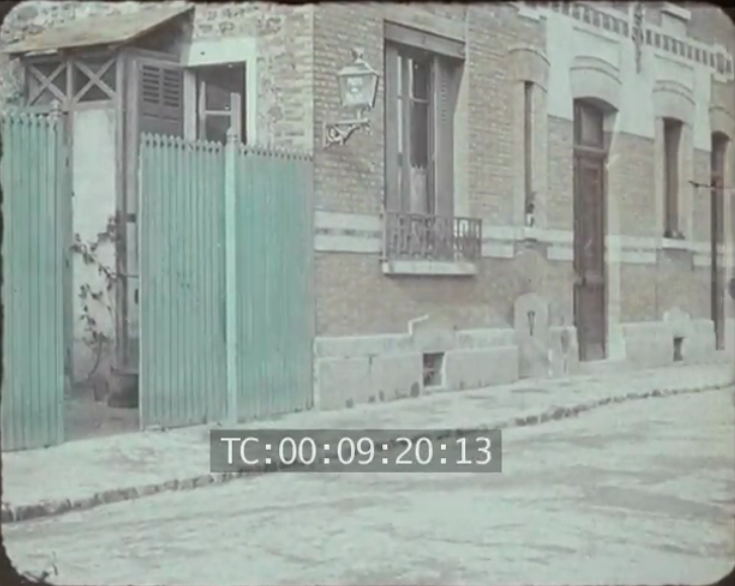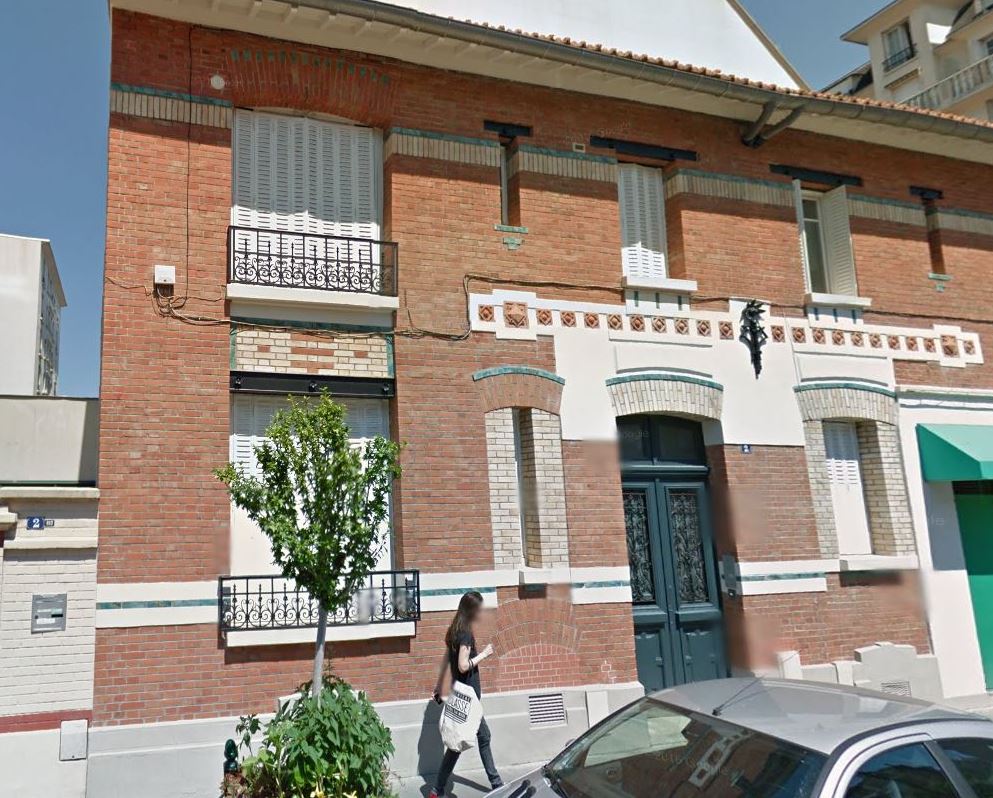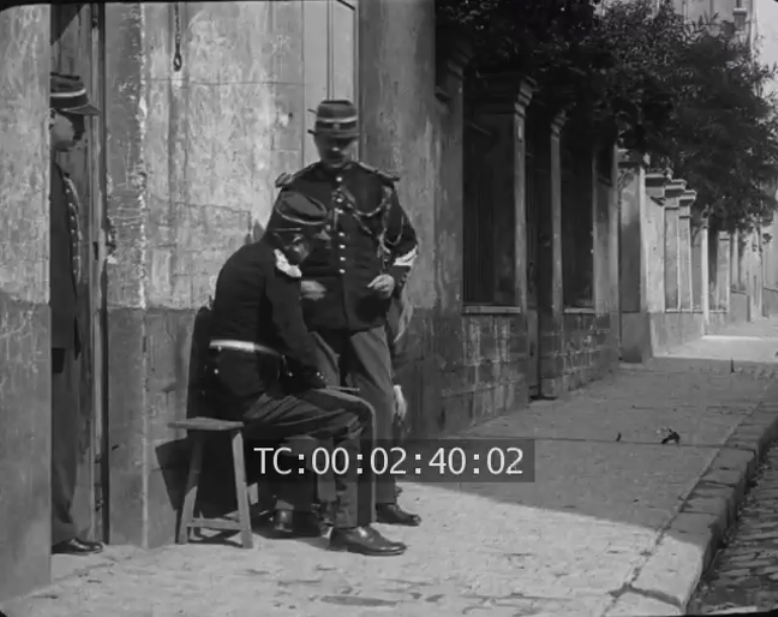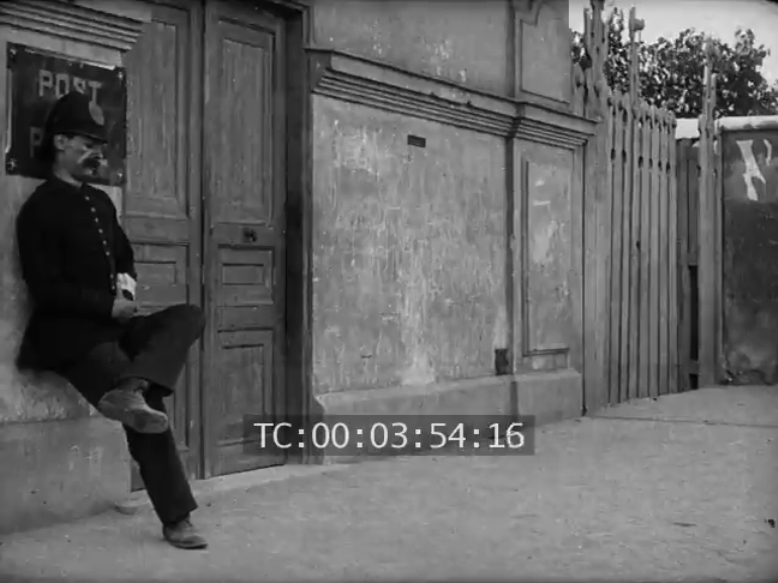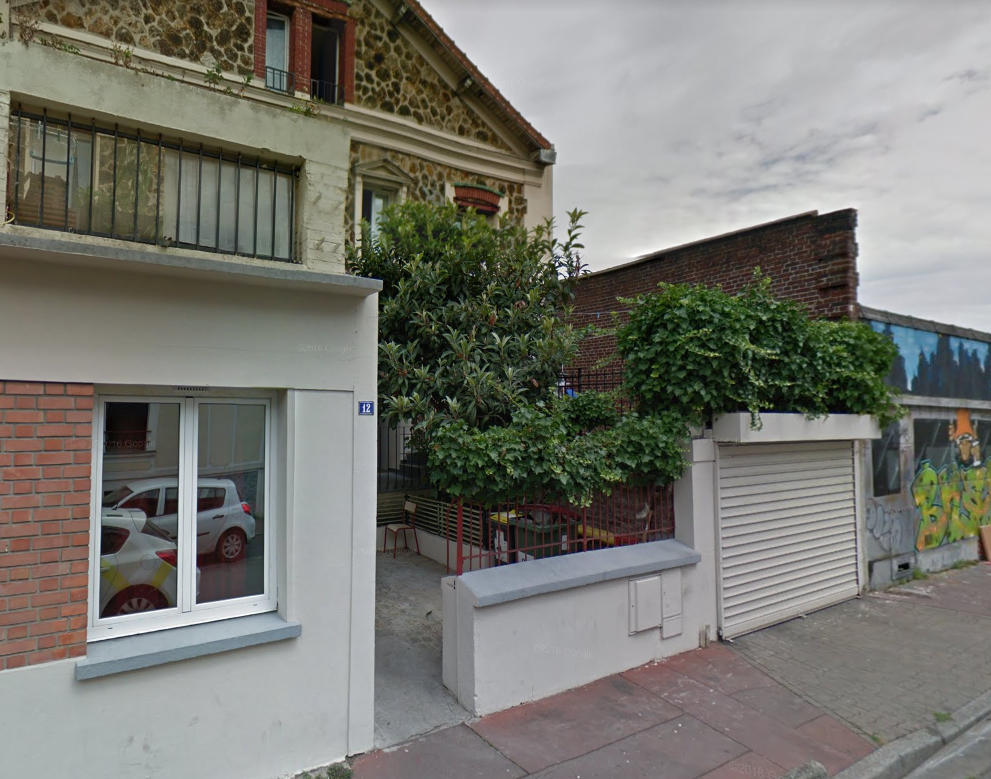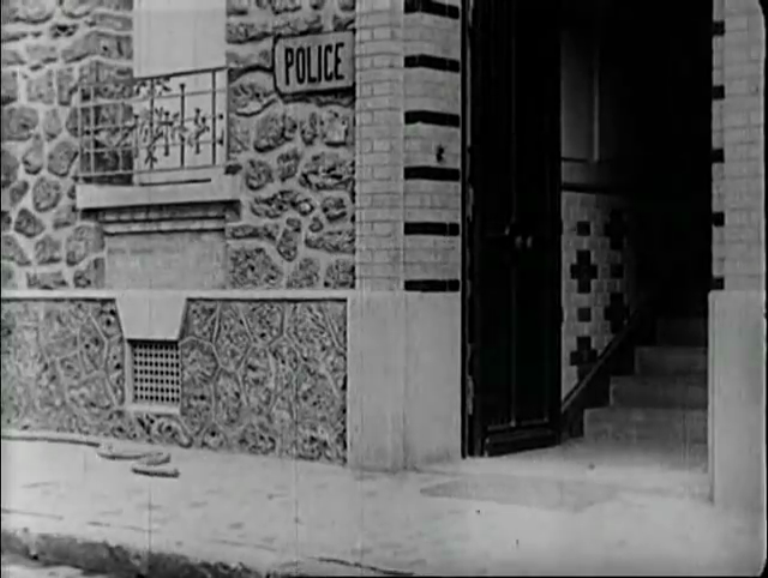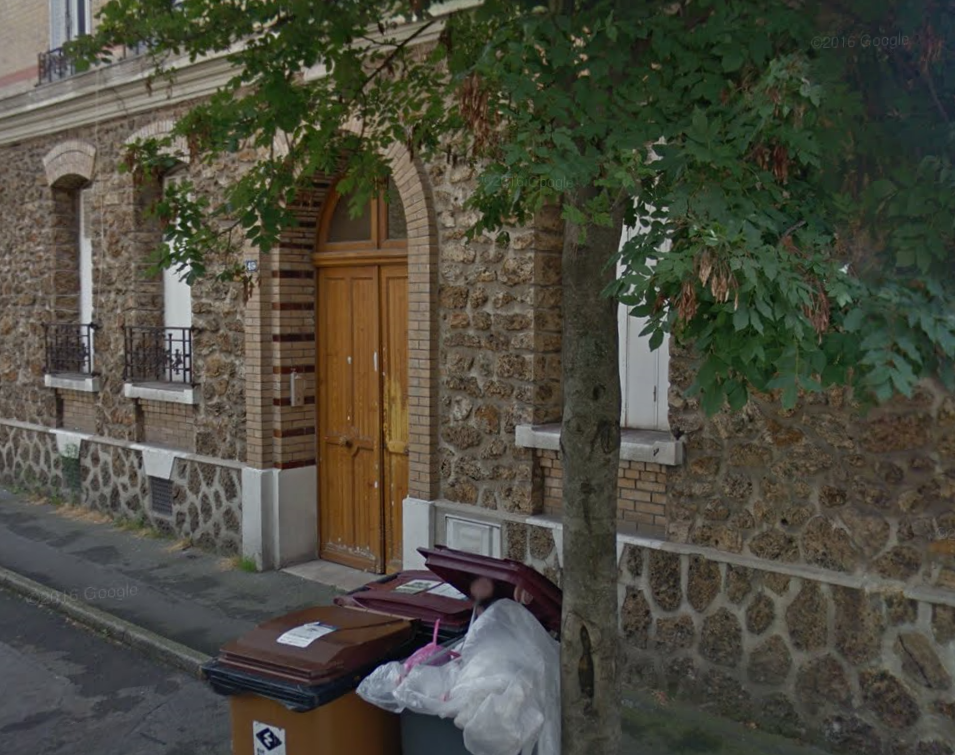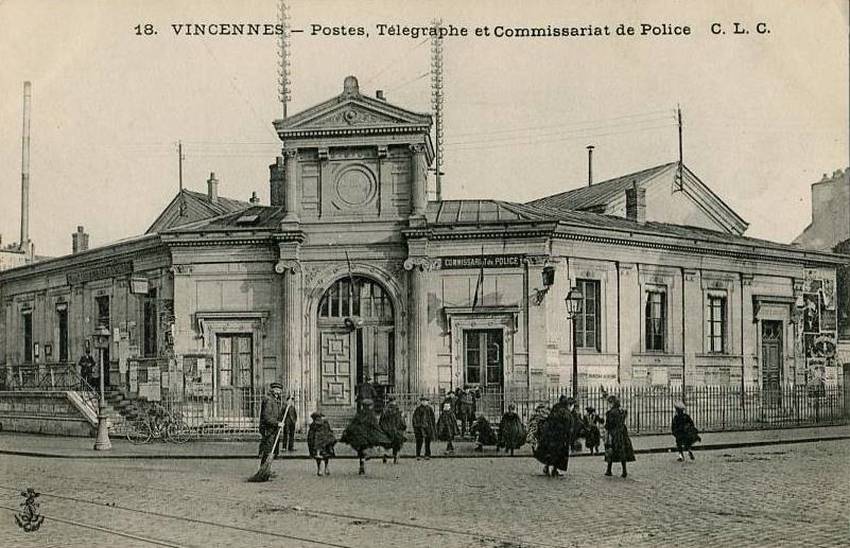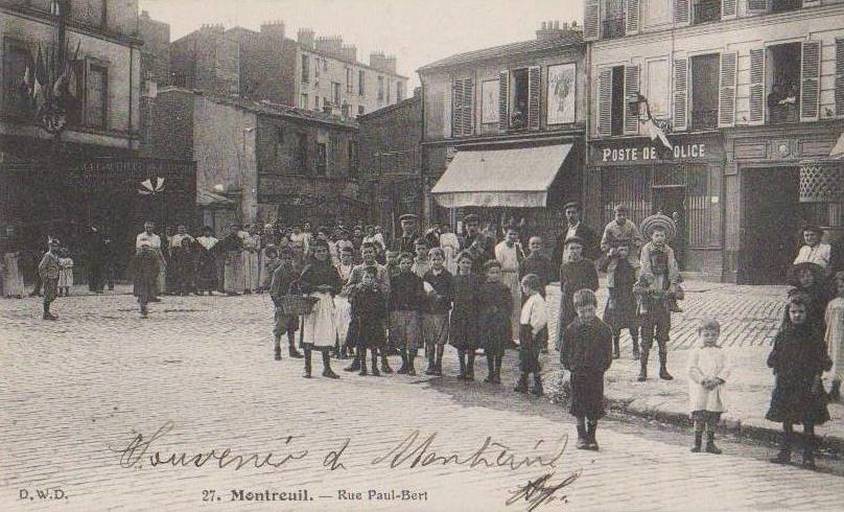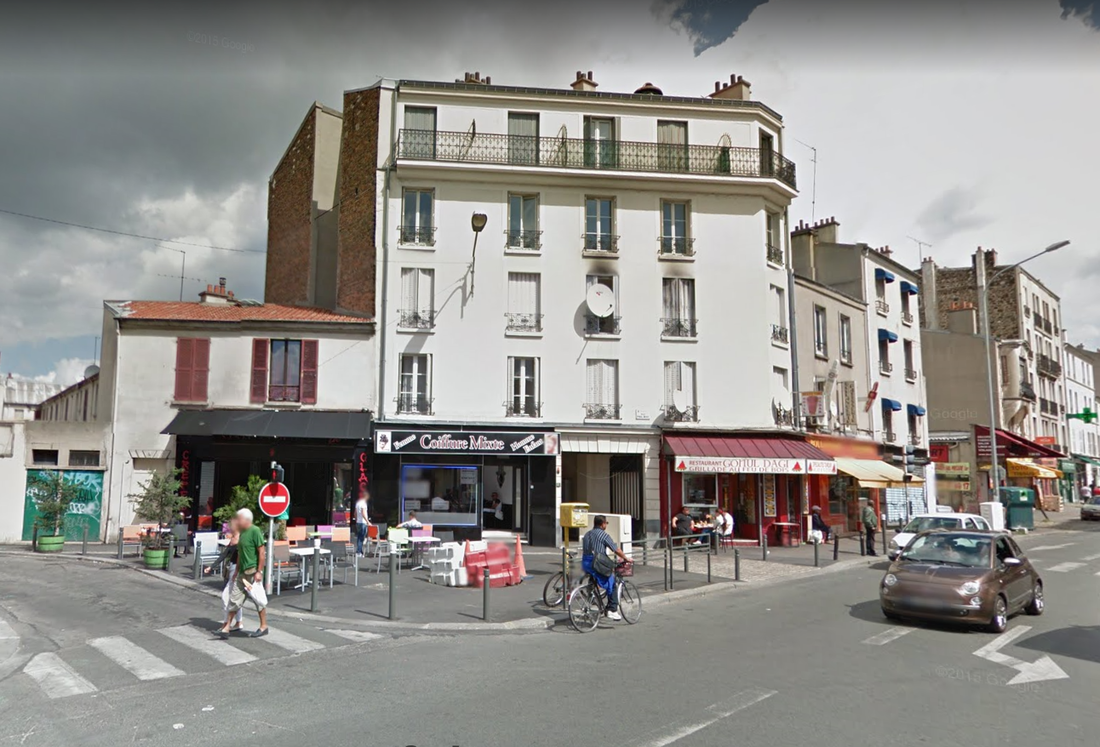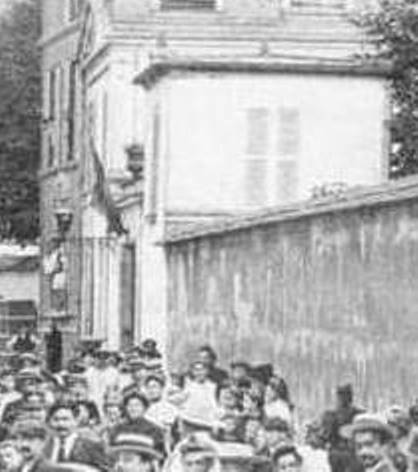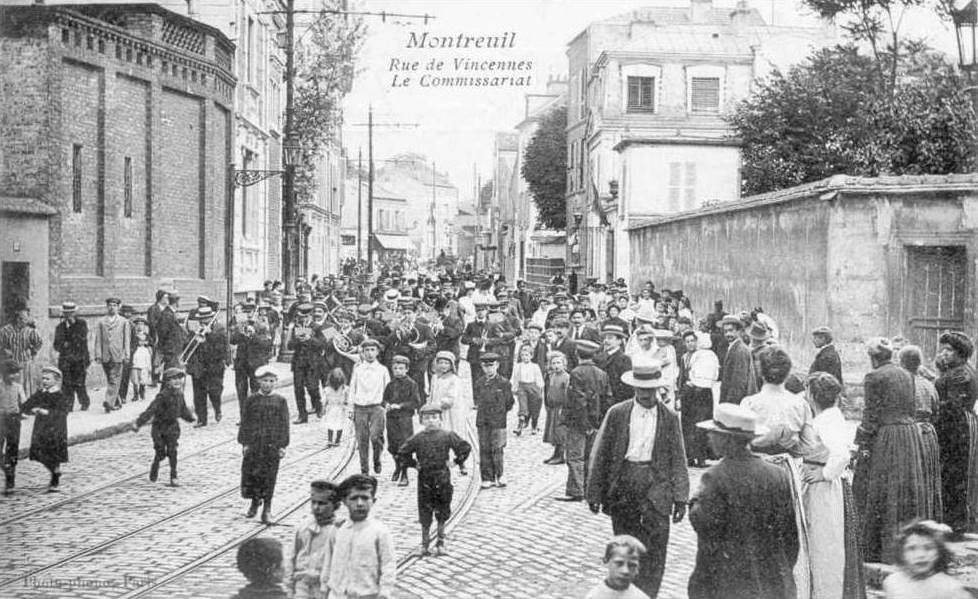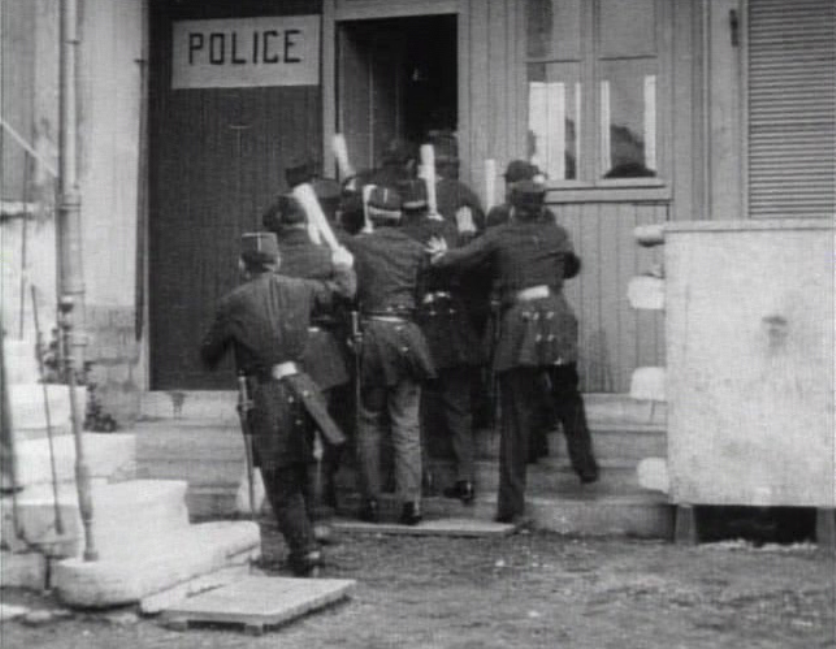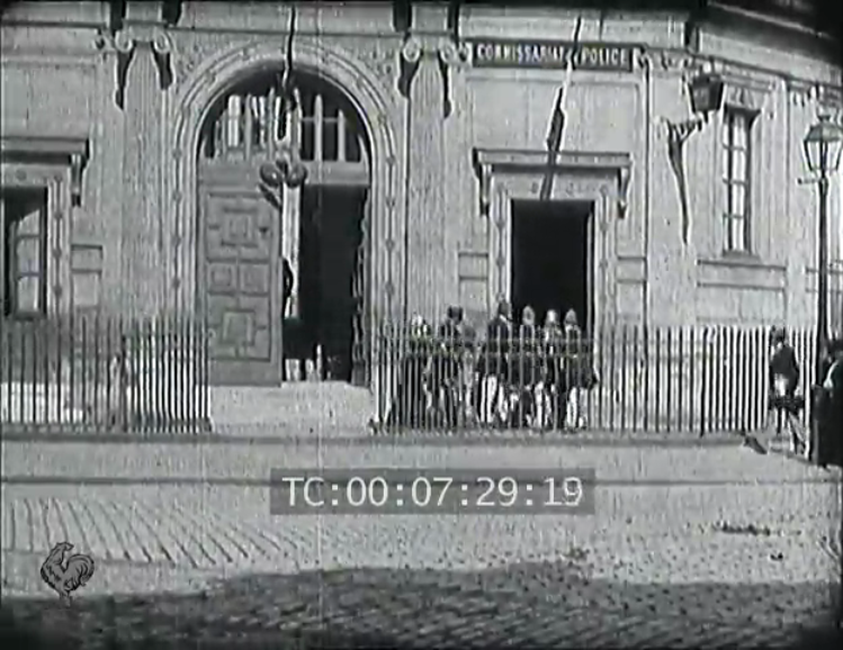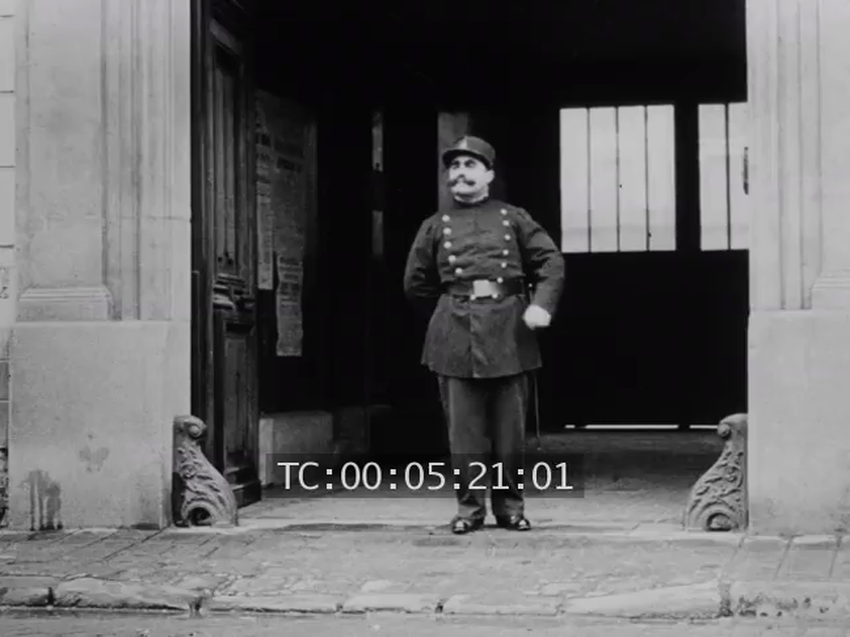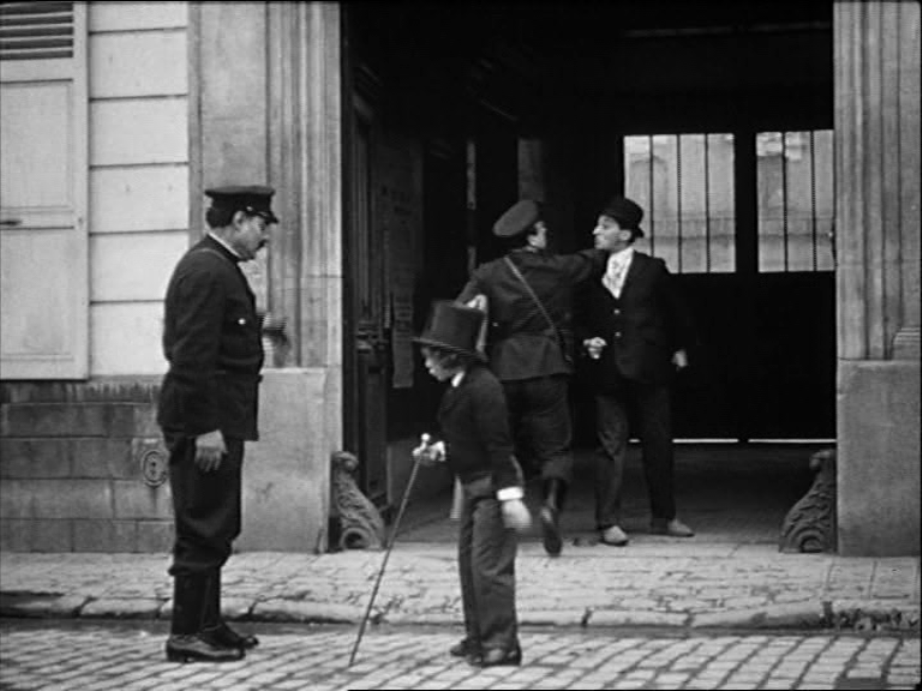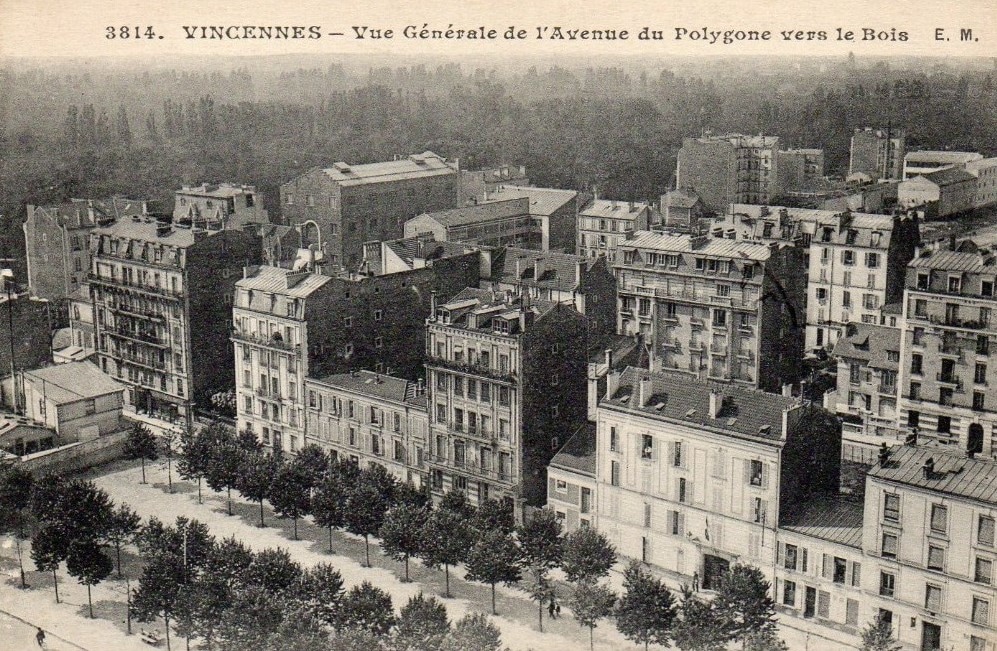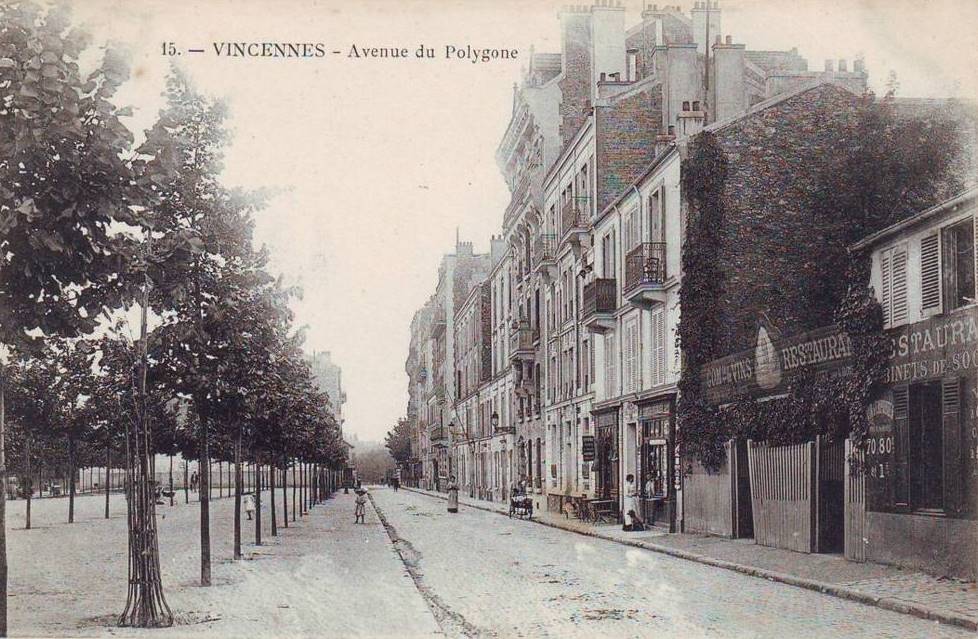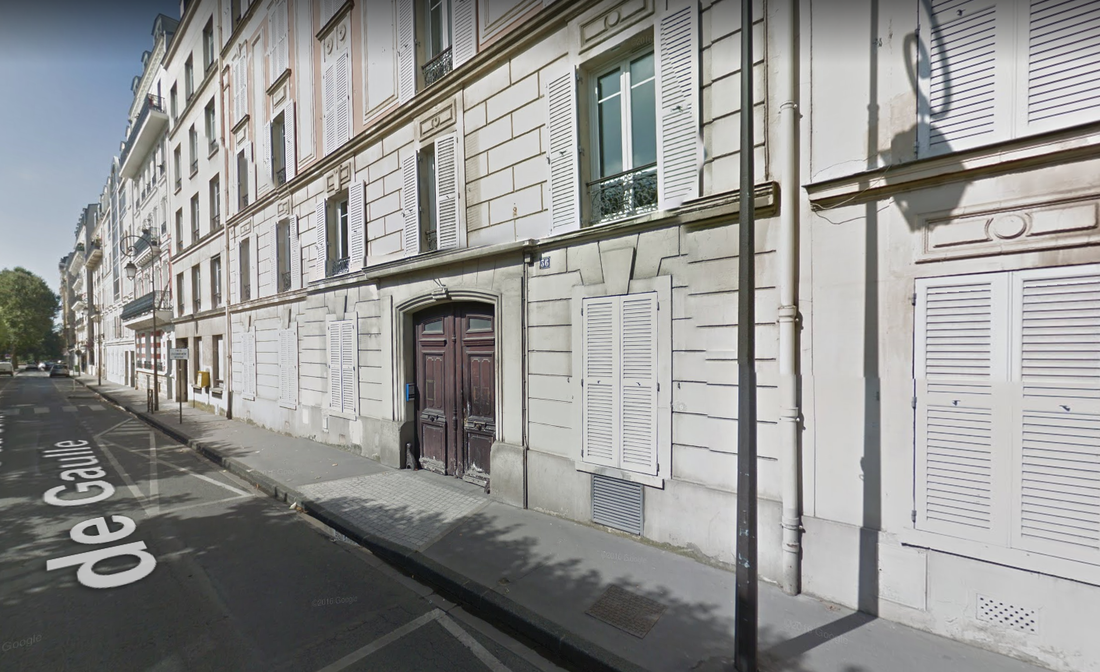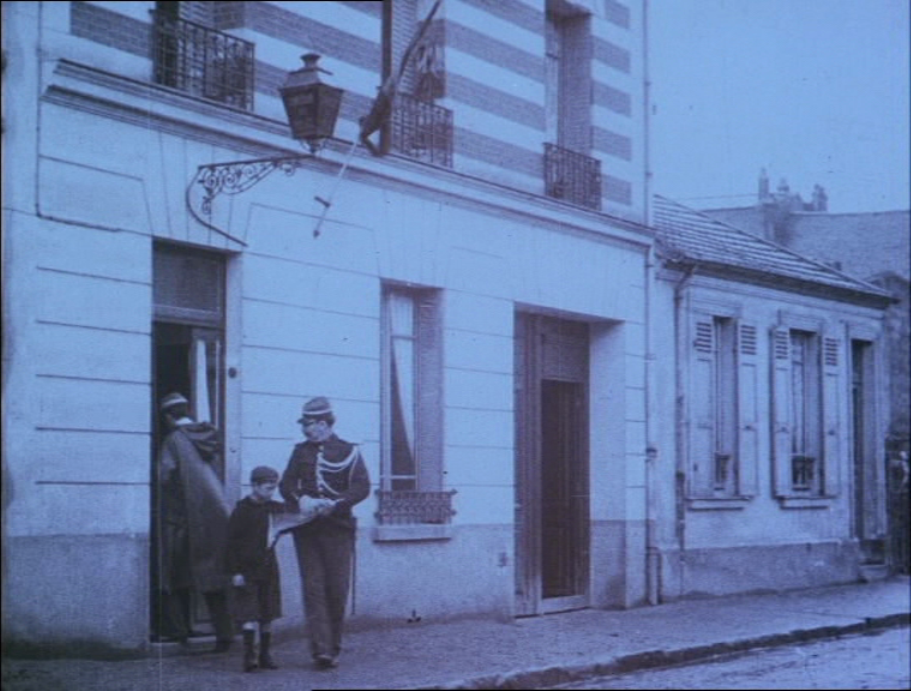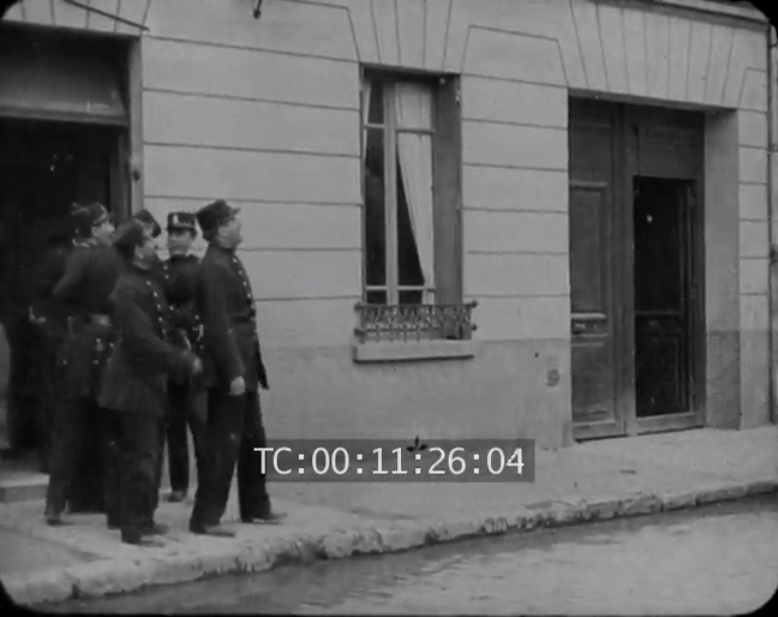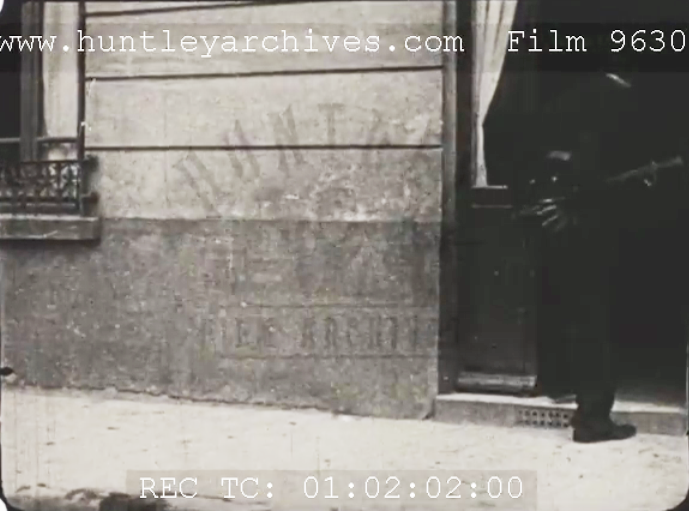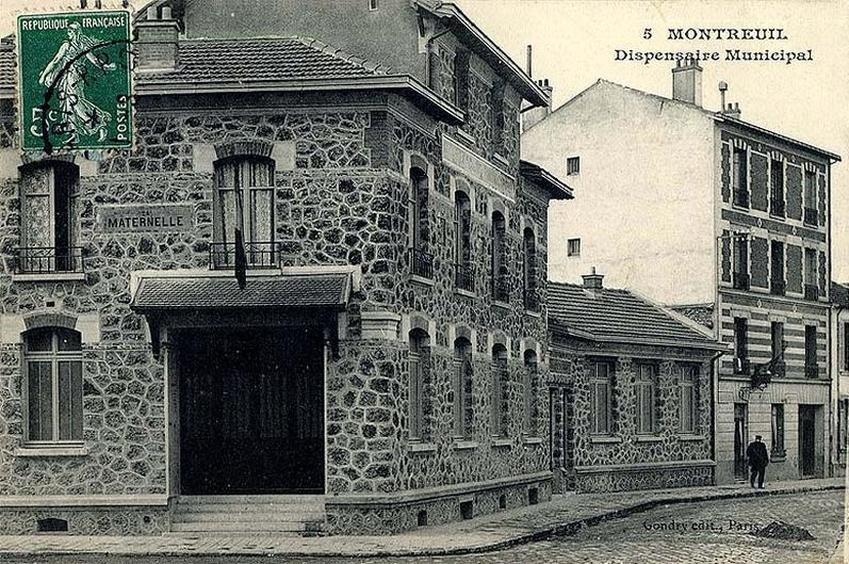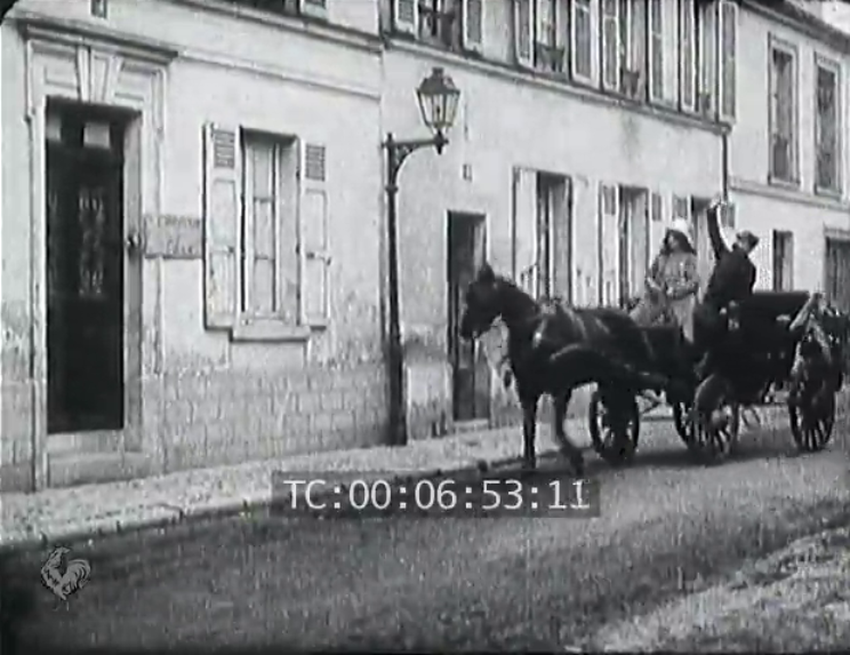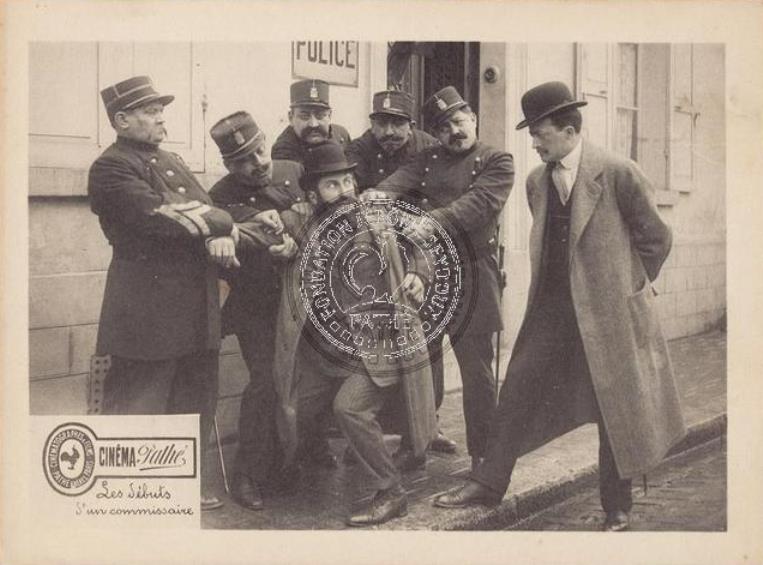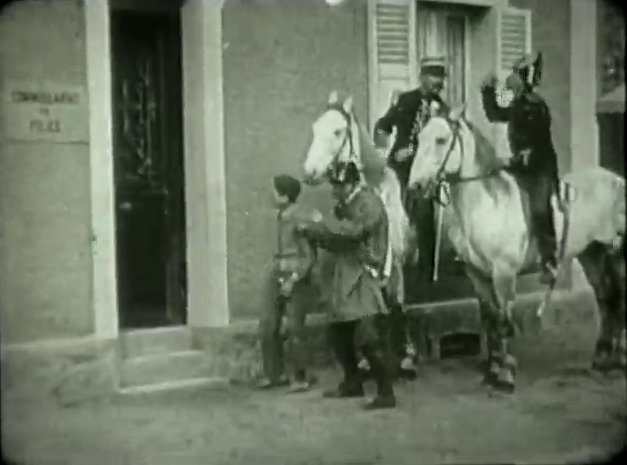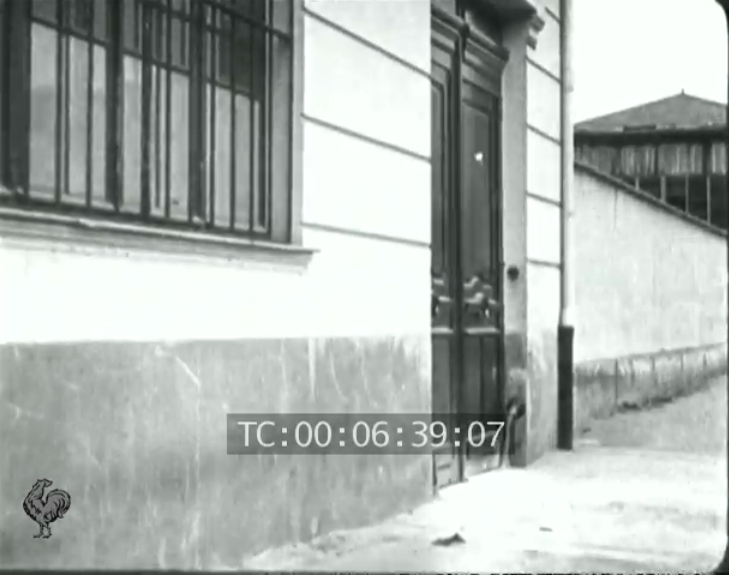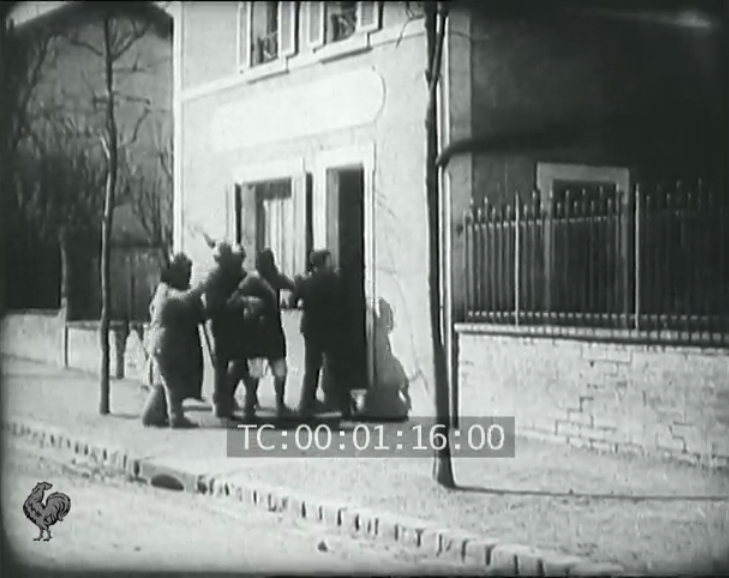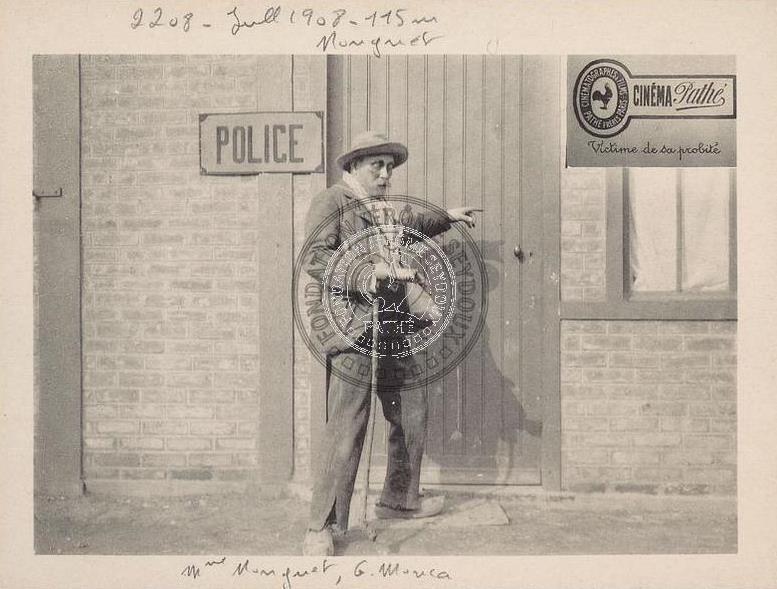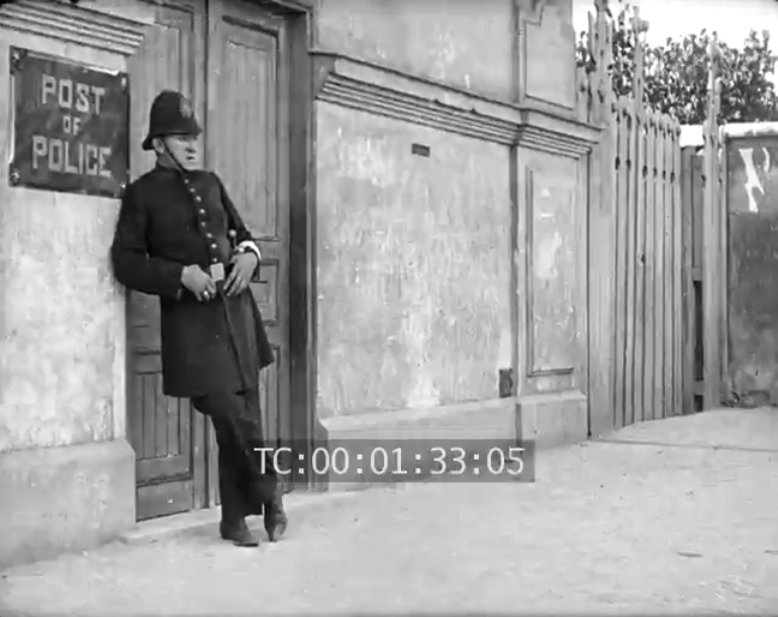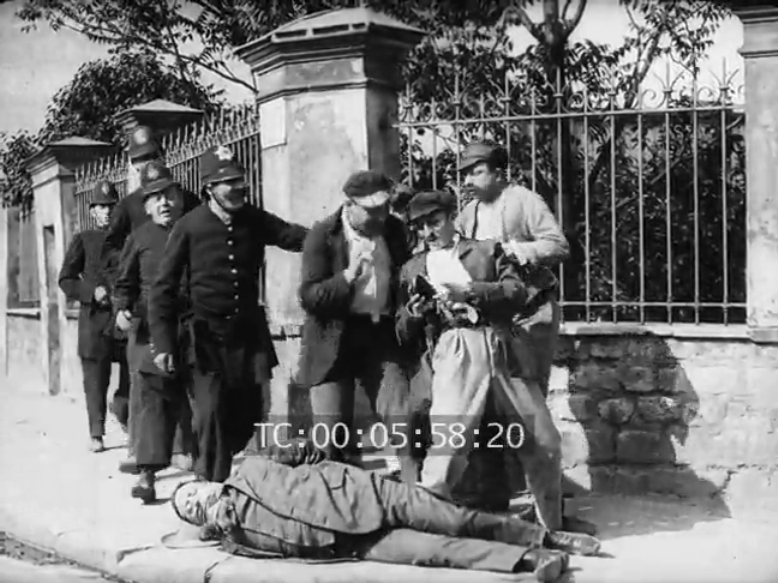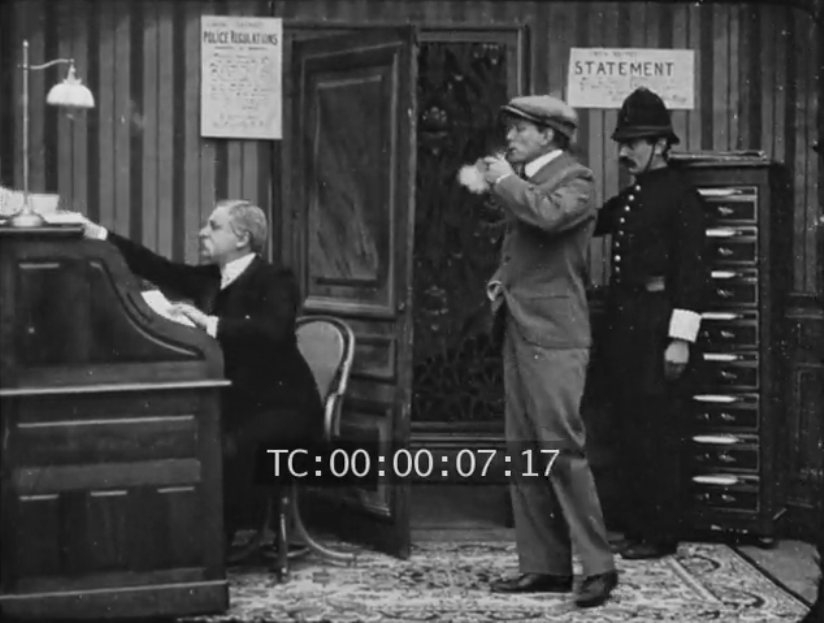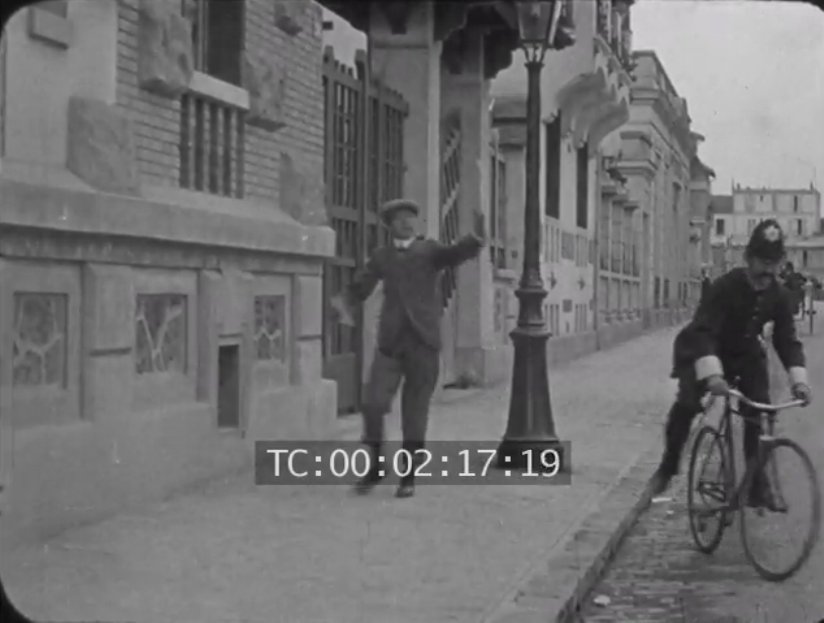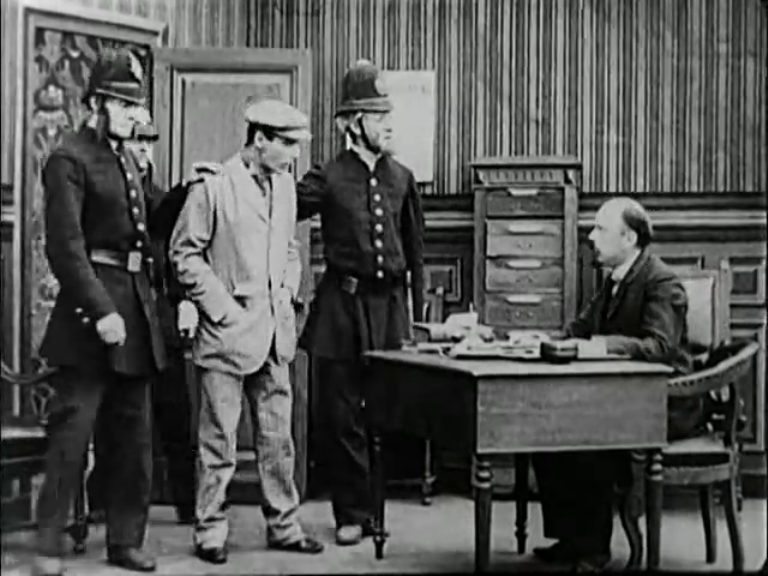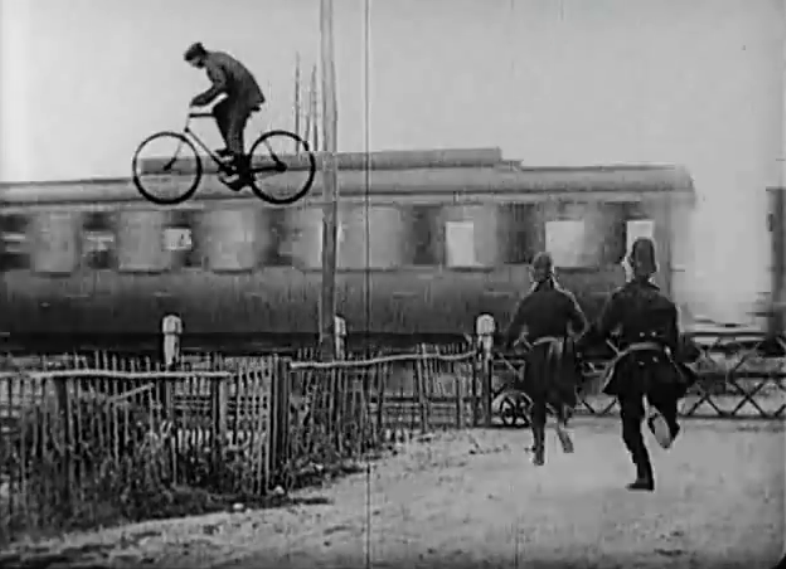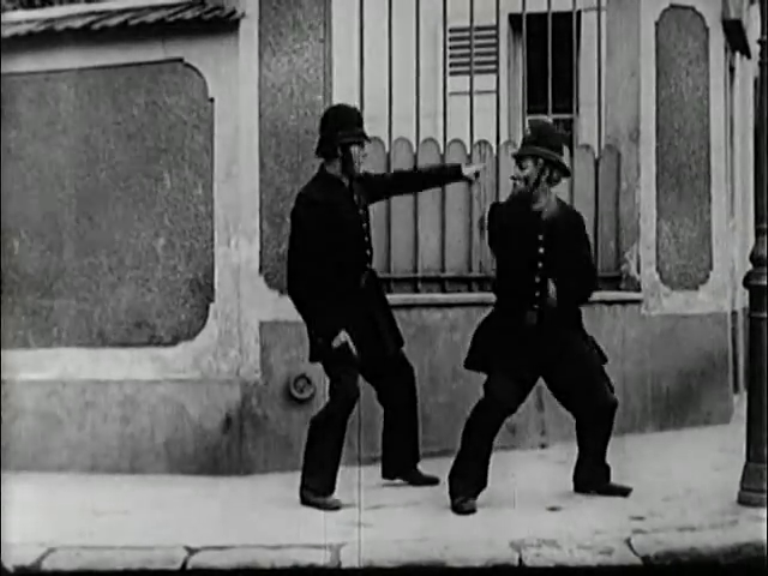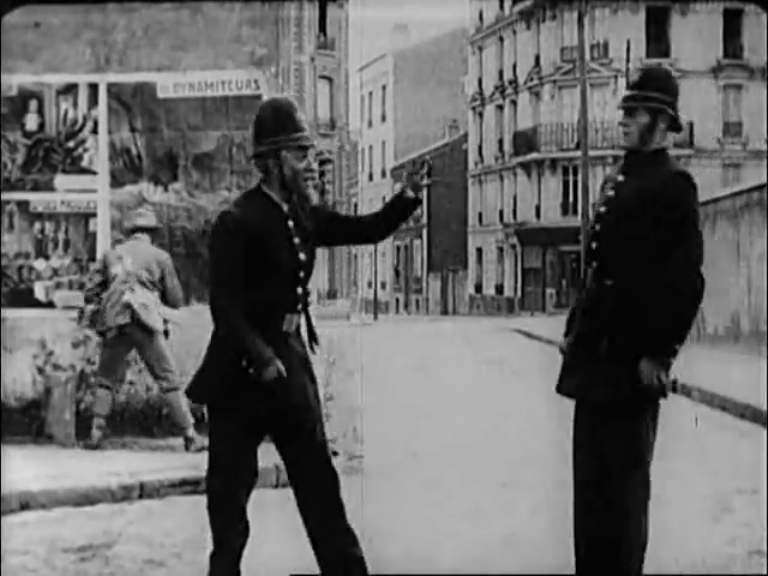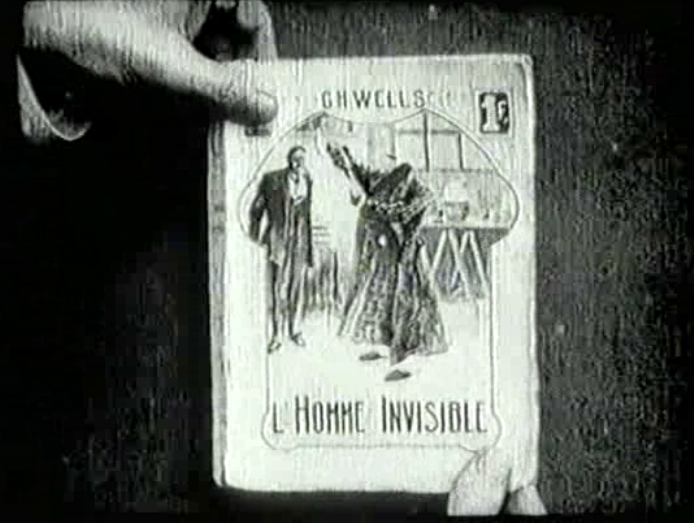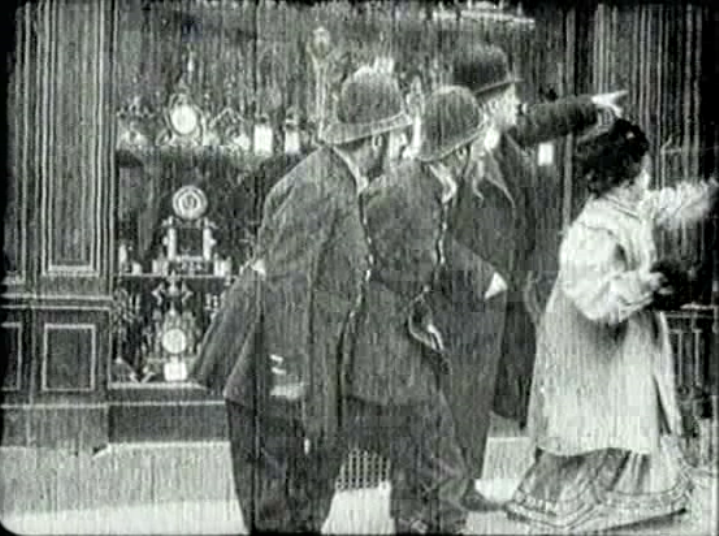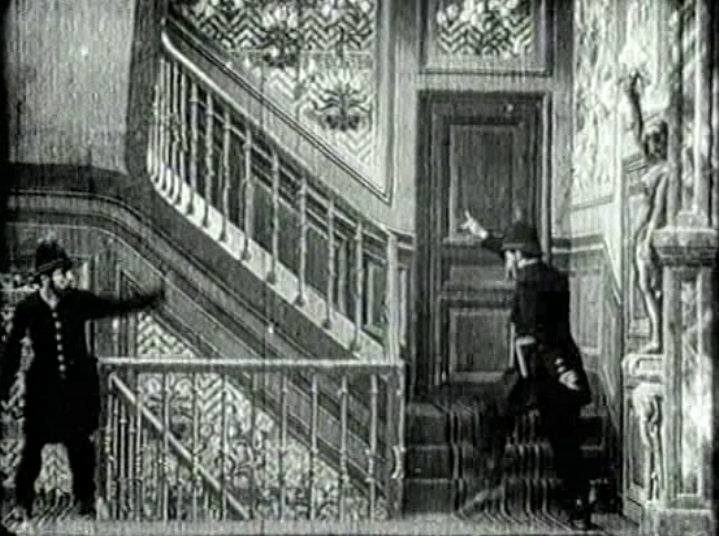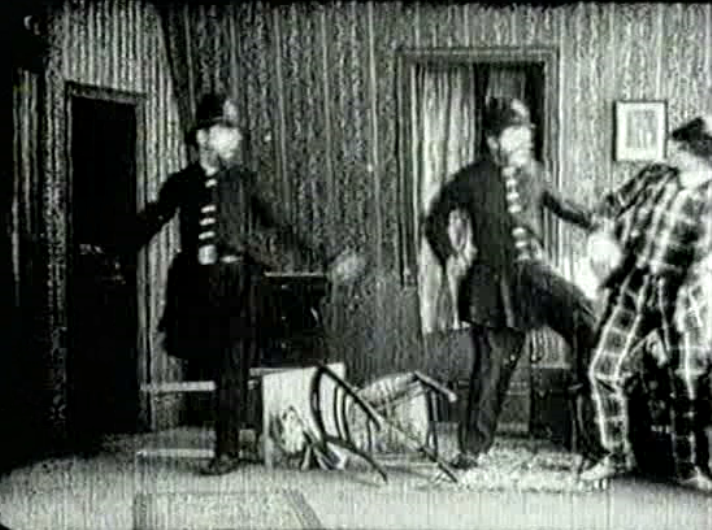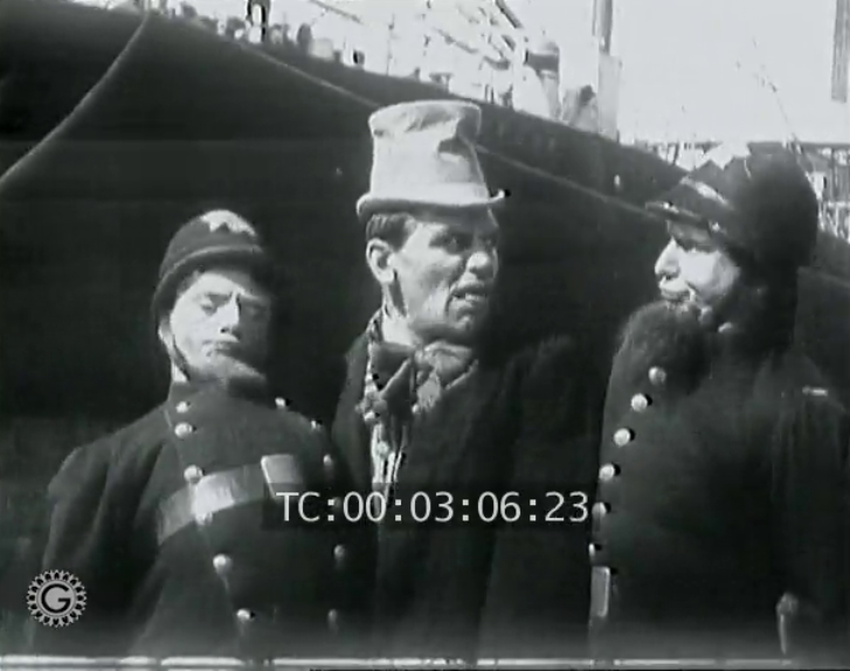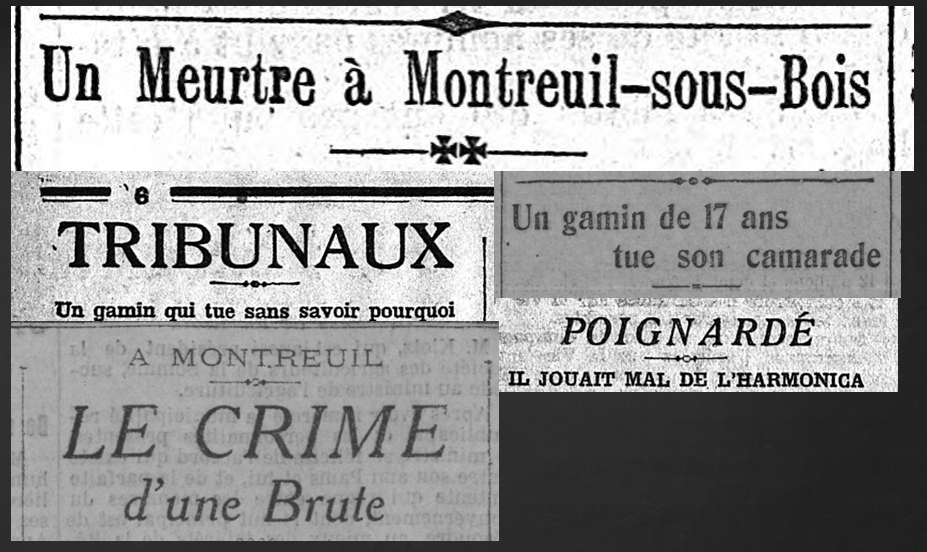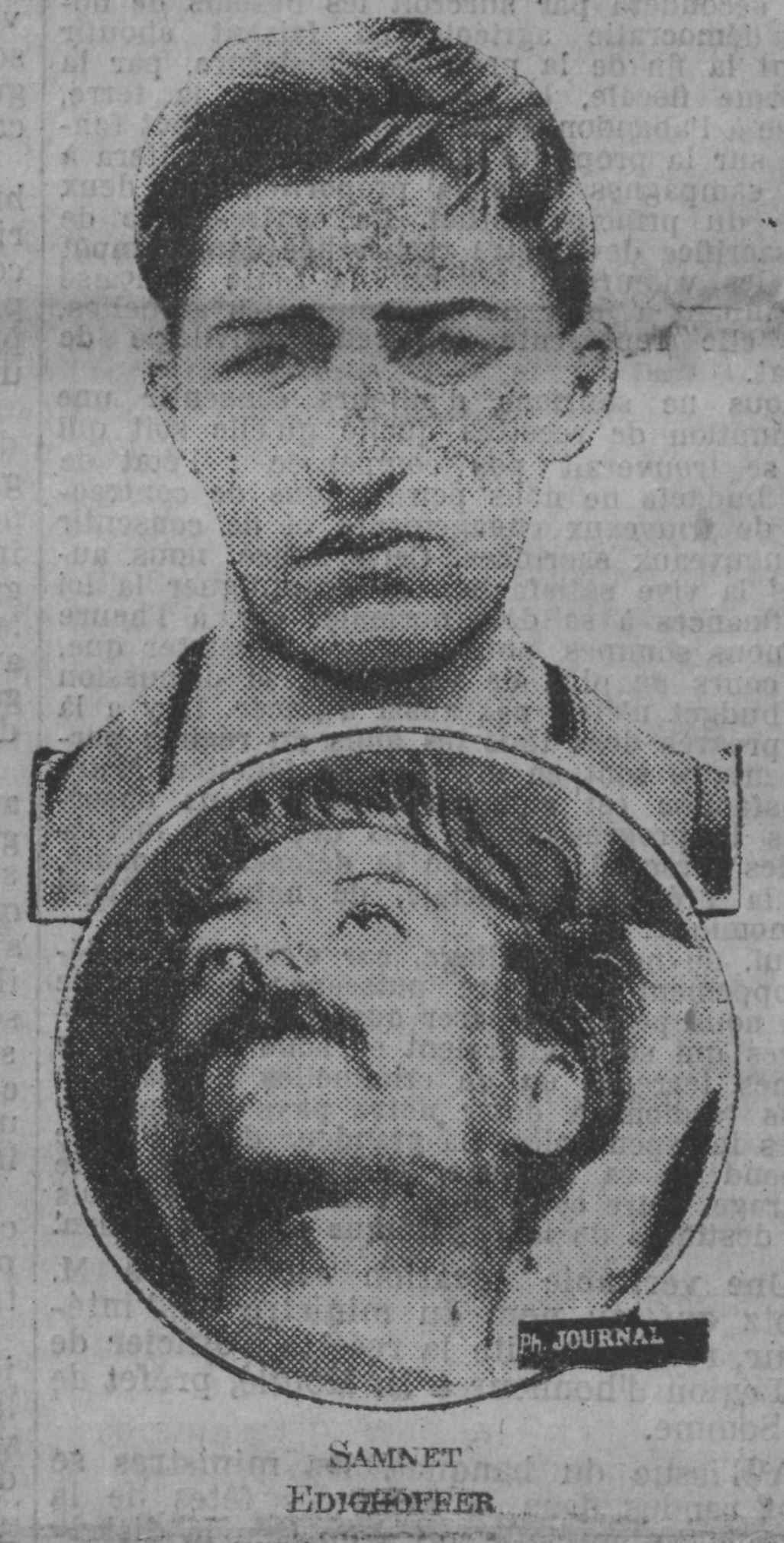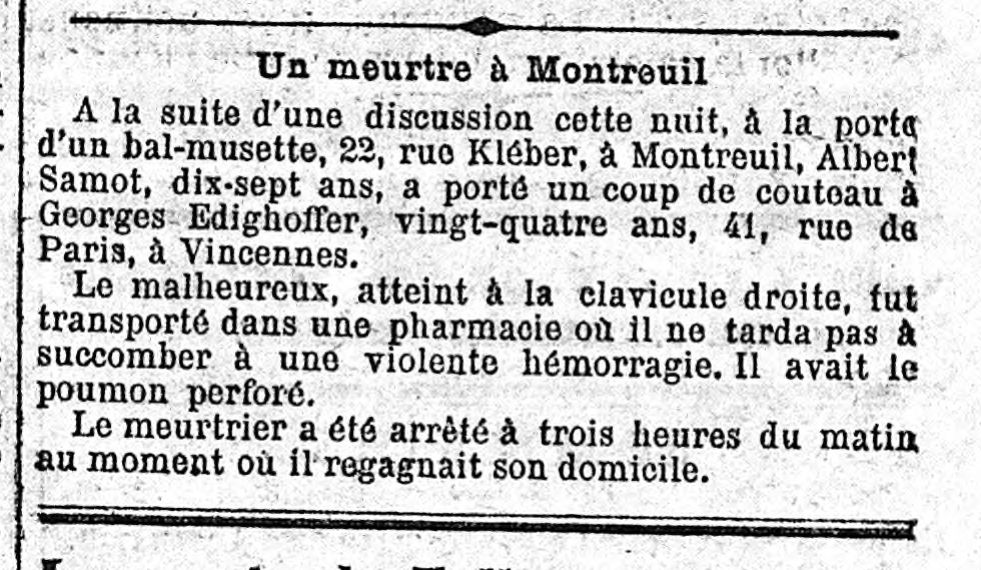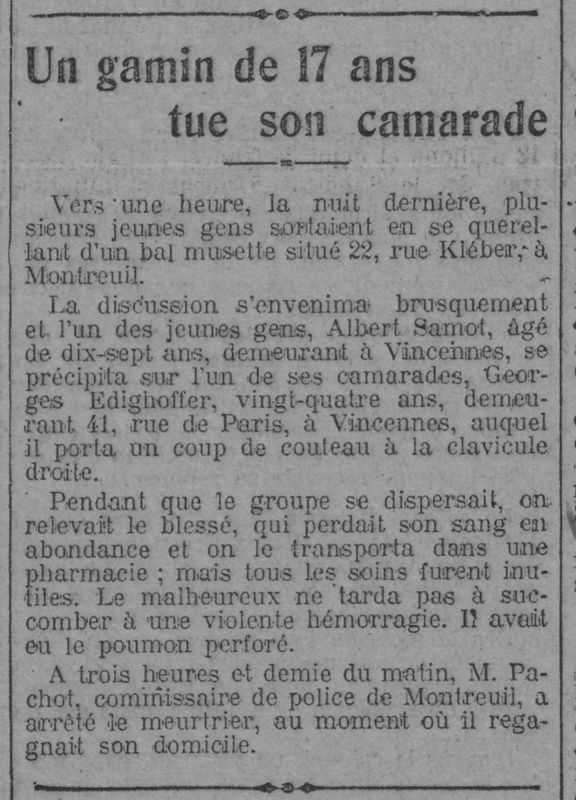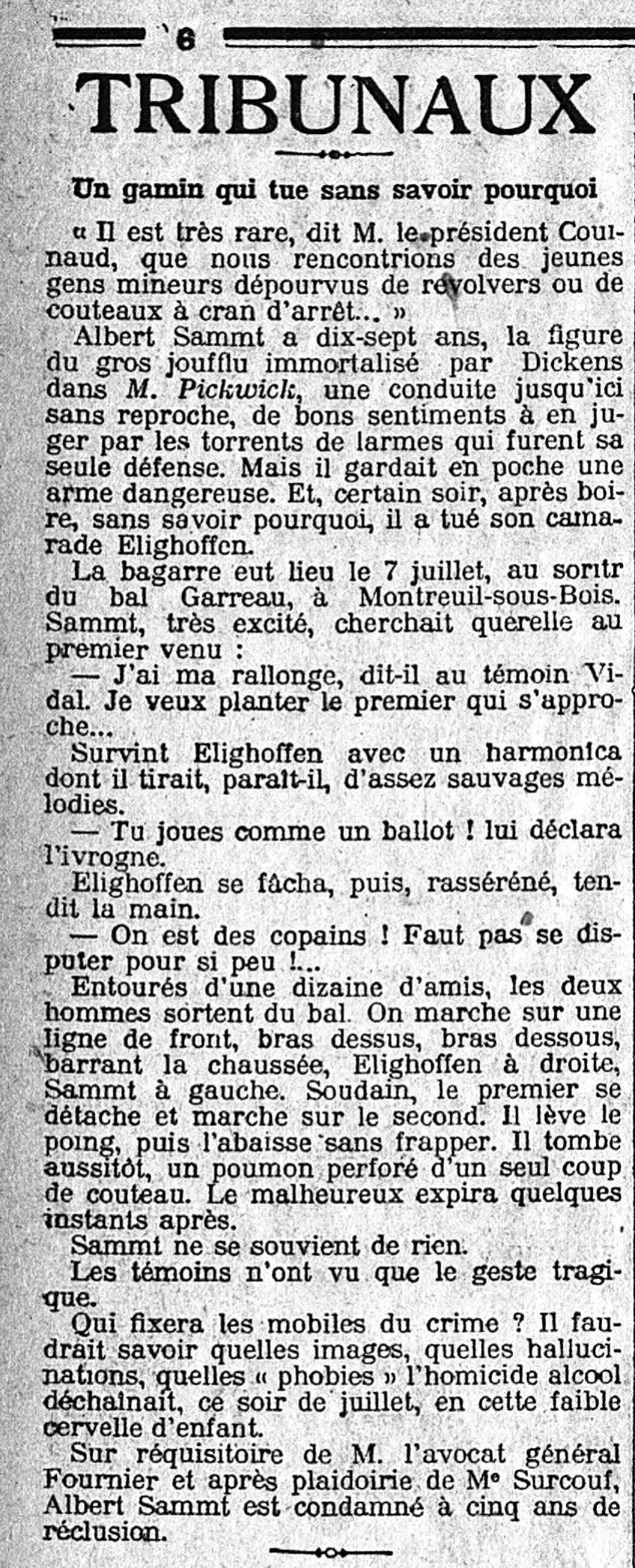Pathé's police stations, 1905-1913
Police stations are common settings in early Pathé films. Their interiors tend to be represented as ordinary offices, with basic furniture and a few posters on the wall. It is the presence of policemen and miscreants that identifies these spaces as police stations:
These interiors are studio constructions. The exteriors of police stations are always real places, though rarely are they actual police stations. Here, for example, is an entrance to the Pathé factory complex on the rue du Bois in Vincennes:
Using your own premises is the simplest way of finding a location. Affixing a sign saying 'POLICE' or placing policemen on duty by the door are the simplest ways of making it pass for a police station. Buildings in nearby Vincennes streets were similarly disguised:
In Les Chiens policiers a characteristic 'poste de police' lamp is affixed to the wall of an ordinary house. The lamp is convincing until it begins to wobble in the wind:
Attaching signs to buildings is an approach also taken by productions based at the studio in Montreuil. Here is a doorway leading to the Pathé studio on the rue du Sergent Bobillot and a door of the Gymnase on the rue du Gazomètre (now rue Edouard Vaillant):
And these two are entrances to private buildings, at 12 rue de la Tourelle (now rue du Sergent Godefroy) and 49 rue Kléber:
These seven different places passing as police stations vary considerably in type, and not many look like official police buildings. If there were no signs attached or uniformed men on duty, probably only the studio building in Vincennes and the Gymnase in Montreuil would be attributed an institutional function of some kind. In reality police stations, whether commissariats or postes de police, were not always recognisable as such, without signage. This is the grand edifice housing the commissariat on the rue in Vincennes:
But here is a poste de police in Montreuil, occupying the ground floor of a modest apartment building at 4 rue Paul Bert:
That locale is now home to a hairdressers':
It seems obvious that a film in need of a police station as setting would have to invent the location, rather than use a real police station, especially if the scenario called for policemen to appear ridiculous. The climax of La Course des sergents de ville (1907) has about twenty policemen chased back to their base by the dog that to begin with they had been chasing. The location is a real place, though I doubt that this is a real poste de police:
We do, however, sometimes see real police stations in Pathé films. In the 1905 Odyssée d'un paysan à Paris, the visitor to Paris is arrested. The commissariat he is taken to is supposed to be in Paris, but this is in fact the Vincennes commissariat we saw in a postcard above:
In both Bébé joue au cinema (1912), aka Bébé victime d'une erreur judiciaire, and Bébé et Jeanne d'Arc (1913) Bébé is taken to a poste de police on the avenue du Polygone (now avenue Charles de Gaulle):
This actually was a poste de police, the one nearest to and most convenient for the Vincennes studio (merci Denis). Again, this is just an ordinary apartment building. Its flag and lamp can just be made out in this postcard:
One specific location is used by three Montreuil-made films to represent a police station:
This is a building at 10 rue Kléber:
When the films were made the left-hand window was a doorway. In the postcard below can be seen, above that doorway, the lamp and flag that designate a police station; that may even be a policeman on duty outside:
This suggests that at some point there was a police station at this address. Newspaper stories from 1912 refer to a commissariat at this end of the rue Kléber, but I haven't yet established what was its relation to the one on the rue de Vincennes. It is remarkable that this police station was used as a location for Pathé films, presumably with the blessing of the policemen inside. It seems that, given also the use of the Vincennes poste de police in two Bébé films, the Pathé filmmakers were on good terms with the local police, even if the films sometimes mocked them.
The ordinary aspect of most of the buildings used to represent police stations in Pathé films means that they are sometimes difficult to identify. Only the assiduous work of Denis Dupont (at Vincennes 1900) to identify films shot near the studios allows us to locate the commissariat de police below left at 6 rue du Donjon (a building now demolished). With no other visual evidence to go on I am far from sure that the poste de police below right is the same building, but I think it is:
Here are some other Pathé police stations that I have not yet located:
Appendix 1: Pathé bobbies
You may have noticed an English policeman standing outside the Gymnase municipal on the rue du Gazomètre in Montreuil, next to an unconvincing sign reading 'Post of Police':
Nothing else in Les Inconvénients du cinématographe (1908) suggests that the setting is England. If anything the apaches who at the end go unarrested are characteristically Parisian. Though the look of English policemen is inherently funny, it is not inherently funnier than that of French policemen, so I assume the use of bobbies in this film is meant just to vary things a little:
Bobbies also feature in the 1907 film Les Faux monnayeurs, but here the setting is explicitly English (Manchester, according to the catalogue description), and the plain-clothes detective who pursues the investigation is stereotypically English (even if the street on which we see him is unmistakably Vincennes):
In Pickpock ne craint pas les entraves (1909), the English inspiration behind the Houdini-like Pickpock, aka Slippery Jim, makes it natural that he be pursued by English policemen:
Likewise, the English source behind Le Voleur invisible (1908) explains why the thief is pursued by bobbies, even if he has clearly bought his copy of H.G. Wells's The Invisible Man from a French bookshop:
I haven't looked closely enough to know if bobbies are as frequent in Gaumont films, but I am rather fond of these two specimens from Calino passager de marque (1910):
Appendix 2: murder in the rue Kléber
|
The news story that tells me that at some point there was a police station at the north end of the rue Kléber, and that leads me to conclude that it was the building we see passing as a police station in three Pathé films, is a sad one of bravura and stupidity leading to murder. Most newspapers tell it as follows: the murderer, Albert Samnet (or Samnit, or Sammt, or Samot, according to which report you read), age 17 or 18, had an argument outside (or possibly inside then outside) a bal-musette at 22 rue Kléber (le bal Garroux or Garreau) with a certain André Lucien (or Lucien André, or Charles André), age 19, over a woman. Apparently Lucien had been dancing with Albert's girlfriend. Albert's friend Georges Edighoffer (or Edigoffer, or Elighoffen), age 24, tried to make peace between the two but this simply made Samnet angrier, so that he stabbed Georges. One report says he showed no remorse, saying that 'it would teach him to mind his own business'. Another says that he 'manifested deep regret for his act, attributing it to drink'. The report adds that he was an excellent worker who was to be married in a few days time.
Two newspapers carry a different version of the story, according to which there was only an argument between Albert and Georges, and that the argument was about the fact that Albert thought Georges played the harmonica very badly. This is the story told in the report of Albert's trial. Albert was sent to prison for five years. |
Here are some of the original news reports of the murder, all from July 8 1912:
